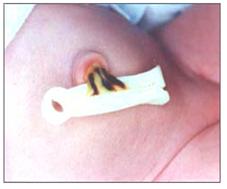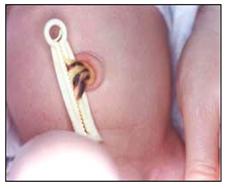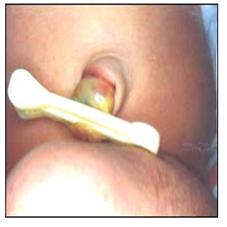한 개 제대동맥(단 제대동맥/ 단일 제대 동맥), Single umbilical artery of newborn infants

사진 89. 건사 중 제대(탯줄) 속에서 2 개 제대 동맥과 한 개의 제대 정맥이 보인다.
Copyright ⓒ 2011 John Sangwon Lee, MD., FAAP

사진 90. 건사 중 제대(탯줄) 속에서 2 개 제대 동맥과 한 개의 제대 정맥이 보인다.
이 때 쯤에는 제대 클램프를 떼도 된다.
Copyright ⓒ 2011 John Sangwon Lee, MD., FAAP
- 제대(탯줄) 속에 2 개의 제대 동맥과 한 개의 제대 정맥이 있는 것이 정상이다.
- 연구에 의하면 단태로 출생한 1,000명의 신생아들 중 5~10명의 신생아들의 탯줄에 단 한 개의 제대동맥이 있고 쌍태로 출생한 1,000명의 신생아들 중 3~4명의 신생아들의 탯줄에 단 한 개의 제대동맥이 있었다.
- 탯줄에 단 한 개의 제대동맥이 있는 신생아들의 ⅓에서 한 종류 내지 여러 종류의 선천성 기형이 발견되었다.
- 이런 이유로 아기가 태어날 때 그들의 태반과 제대 혈관을 통상적으로 검사하는 것이 보통이다.
| 한 개 제대동맥(단 제대동맥) |
Single umbilical artery
- 11,115명의 태아와 신생아들의 제대동맥의 수를 16년 동안 연구했다. 그 연구에 의하면, 제대에 동맥이 정상적으로 두 개 있는 신생아들에 비해서 제대 동맥이 한 개만 있는 신생아들에게 복합적 선천성 기형 내지 하지 기형, 중추신경계 기형, 소화기계, 또는 비뇨기계 기형 등이 더 많이 발견됐다.
- 쌍 태아로 태어난 신생아들에게 단 제대가 더 많이 발견됐다.
- 단 제대 동맥이 있는 태아 7명이 유산됐고 신생아들 11명이 사망했고 저 체중 출생아들의 주산기 사망률이 증가됐다.
- 그 후 다른 연구에 의하면 39,773명의 태아들과 신생아들 중 0.9%(344명)에서 단 제대동맥이 발견됐고 그중 1.2%는 백인이었고 0.5%는 흑인이었다.
- 344명 중 48명(14%)이 유산되었거나 주산기, 신생아기, 또는 영아기 중에 사망했다.
- 2개의 제 동맥혈관을 정상적으로 가진 대조군(콘트롤 군)에서는 3.8%가 유산되거나 주산기, 신생아기나 영아기 중에 사망했다.
| 단 제대동맥이 있는 296명을 생후 4년 동안 추적 관찰 연구 결과 |
- 단 제대동맥이 있으면서 사망한 태아들, 신생아들이나 영아들의 부검결과에서 선천성 기형률은 52.8%이었고 그들은 심한 선천성 기형으로 조기에 사망했다.
- 단 제대동맥이 있으면서 주산기, 신생아기나 영아기에 아무 이상이 없이 지나면 그 후 거의가 정상적으로 성장 발육했다.
- 서혜부 탈장, 무항문증, 십이지장 폐쇄, 기관 식도 누관(루) 등의 선천성 기형이 신비뇨 생식기계, 심장혈관순환기계, 소화기계 등에 좀 더 많이 발생됐다.
- 단 제대동맥이 있으면서 다른 기형이 없는 아이들에게 육체적 정신적 성장발육 문제가 생길 확률은 두 제대동맥이 정상적으로 있는 아이들과 거의 동등하게 4.2%정도이다.
- 이 두 연구는 단 제대동맥에 관해 가장 광범위하게 한 연구이다.
- 분만 후 태어난 아기를 돌보는 일도 세심히 해야 하지만 분만 후 태반의 크기, 모양, 형태 등을 살펴보는 것도 아주 중요하다.
- 가령 태반의 무게가 700gm 이상 되면 임신부에게 당뇨병이 있나 의심해야 한다.
- 제대의 길이가 30cm 이하로 짧으면 신생아에 어떤 기형이 있나 의심해보고 제대에 동맥혈관이 하나만 있으면 이상 설명한 기형이 있을 가능성이 좀 더 있다고 생각해야 한다.
- 아기가 태어난 후 태반과 탯줄에 관해서도 부모들이 알아야 할 의학지식이다.

사진 91. 건사되지 않은 제대
Copyright ⓒ 2011 John Sangwon Lee, MD., FAAP
|
다음은 “한 개 제대동맥과 제대혈관”에 관한 인터넷 소아청소년 건강상담 질의응답의 예 입니다. |
Q&A. 한 개 제대동맥과 제대혈관에 관하여
Q.
저희 아가는 태어난 지 10일된 여아입니다,,제왕절개로 3.0kg으로 건강하게 세상과 인사를 했지요, 그런데 탯줄에 있어야할 동맥이 하나밖에 없다는 청천벽력같은 소릴 들었습니다,,샘님은 저에게 위로를 하시는 건지 아이가 지금상태로는 건강하고 오줌도 잘 싸고하니 별문제 없을 거 같다고 하십니다, 그 병원에서는 정밀 초음파가 없어 좀 더 큰 병원 가서 하라고 소견서를 써 주셨는데여,,아직 검사는 안한 상태입니다,
넘 겁도 나고 만약 이상이 있다면 어떤 문제를 야기 시키는지, 그리고 어떤 방법으로도 생활하는데 지장은 없는 건지, 뇌발달이나 운동발달에 영향은 없는 건지 넘 답답합니다,
이런 경우는 특이한 경우라 정보자료도 찾기가 힘드네여, 선생님 저에게 희망을 주세여.
A.
수창님
안녕하세요. 질문해 주셔서 감사합니다. 좋은 질문입니다.
그 동안 휴가로 한국 팔도강산을 여행하고 돌아왔습니다. 답변이 늦어 죄송합니다.
자녀의 나이, 성별, 과거 병력, 가족 병력, 진찰소견, 임상검사 등의 정보를 많이 알수록 답변을 드리는데 도움이 됩니다. 주신 정보를 토대로 해서 답변을 드리겠습니다.
제 생각으로는 지금은 아무 검사도 걱정도 하실 필요가 없다고 생각합니다.
그러나 어떤 이상이 생기면 그때 필요에 따라 검사하시기 바랍니다.
질문이 더 있으면 다시 연락해 주시기 바랍니다.
한 개 제대동맥 등을 참조하시기 바랍니다. 감사합니다.
이상원 드림
|
다음은 “한 개 제대동맥과 제대혈관”에 관한 인터넷 소아청소년 건강상담 질의응답의 예 입니다. |
Q&A. 한 개 제대동맥
Q.
탯줄에 있는 제대동맥이 한 개뿐이 라네요. 머리 두께도 6m이라면서 보통 애기들보다 두껍 다네요. 기형이 될 수 있다면서 병원에서 서울아산병원에 가서 정밀진단을 받으라는데 넘넘 걱정입니다. 지금은 강릉아산병원에 다니고 있고요. 어떻게 하면 좋을지 선생님 기형이 될 수 있나요?
A.
미라님
안녕하세요. 질문해 주셔 감사합니다.
자녀의 나이, 성별, 과거와 가족의 병력, 진찰소견, 임상검사 결과 등 자세한 정보가 있으면 답변을 드리는 데 많은 도움이 됩니다. 주신 정보를 참작해 답변을 드립니다.
한 개 제대동맥에 관한 질문에 관해 답변을 드리기 위해서 다시 문헌을 찾아 [부모도 반의사가 되어야 한다– 소아가정간호 백과]-제 6장 신생아 질환-“한 개 제대동맥(단 제대동맥 Single umbilical artery)”에 추가 정보를 방금 올렸습니다.
본래 있던 정보와 함께 참고 하시기 바랍니다.
더 자세한 정보는 담당 의사에게 문의하시고 더 필요한 정보가 있으시면 다시 연락해 주시기 바랍니다.
Single umbilical artery of newborn infants 한 개 제대동맥(단 제대동맥/ 단일 제대 동맥)

Picture 89. Two umbilical arteries and one umbilical vein are normally visible in the umbilical cord during dry. Copyright ⓒ 2011 John Sangwon Lee, MD., FAAP

Picture 90. Two umbilical arteries and one umbilical vein are visible in the umbilical cord during dry. At this point, the umbilical clamp may be removed. Copyright ⓒ 2011 John Sangwon Lee, MD., FAAP
It is normal to have two umbilical arteries and one umbilical vein in the umbilical cord .
Studies have shown that out of 1,000 newborns born in singleton, 5-10 newborns have only one umbilical artery in the umbilical cord, and out of 1,000 newborns born in twins, 3-4 neborns have only one umbilical artery.
One to several types of congenital anomalies were found in ⅓ of newborns with only one umbilical artery in the umbilical cord. For this reason, it is common for babies to routinely examine their placenta and umbilical vessels at birth.
One umbilical artery (only umbilical artery/ single umbilical artery
The number of umbilical arteries in 11,115 fetuses and newborns was studied for 16 years.
The study found that newborns with only one umbilical artery were found to have more complex congenital or lower extremity anomalies, central nervous system anomalies, digestive or urinary system anomalies than newborns with two normal arteries in the umbilical cord.
Single umbilical cords have been found in more newborns born with twin fetuses. However, 7 fetuses with sinle umbilical artery were miscarried,
11 newborns died, and the perinatal mortality rate of low-weight births increased. Later, another study found a single umbilical artery was found in 0.9% (344) of 39,773 fetuses and newborns, of which 1.2% were white and 0.5% were black. Of the 344, 48 (14%) were miscarried or died during perinatal, neonatal, or infancy.
In the control group with two arterial vessels normally, 3.8% aborted or died during perinatal, neonatal, and infancy. However, the results of a follow-up study of 296 patients with umbilical artery during 4 years of age.
However, in the autopsy results of fetuses, newborns and infants who died with the single umbilical artery, the congenital anomaly rate was 52.8%, and they died early from severe congenital anomalies. However, when there was no abnormality in the perinatal, neonatal, or infancy period with the sigle umbilical artery, most of them grew and developed normally.
Congenital anomalies such as inguinal hernia, duodenal obstruction, and tracheal esophageal fistula were more common in the mystic urine reproductive system, cardiovascular circulatory system, and digestive system. However, the probability of physical and mental growth and development problems in children with umbilical arteries and no other malformations is about 4.2%, almost equal to that of children with normal umbilical arteries.
These two studies are the most extensive studies on the single umbilical artery. Care for a baby born after delivery should be done carefully, but it is also very important to examine the size, shape, and shape of the placenta after delivery.
For example, if the placenta weighs more than 700gm, you should suspect that a pregnant woman has diabetes.
If the length of the umbilical cord is short, less than 30cm, you should be suspicious of any abnormalities in the newborn, and if there is only one arterial blood vessel in the umbilical cord, you should think that there is a little more possibility of the above-described malformation.
The placenta and umbilical cord after a baby is born is also a medical knowledge that parents should know.

Picture 91. An undry umbilical cord. Copyright ⓒ 2011 John Sangwon Lee, MD., FAAP
The following is an example of online pediatric and adolescent health consultation questions and answers about “one umbilical artery and umbilical vessel”.
Q&A.
About one umbilical artery and umbilical vessel
Q.
My baby is a girl who is 10 days old, and he said goodbye to the world with a cesarean section at 3.0kg. However, I heard that there is only one artery in the umbilical cord, and Sam comforts me.
Guernsey said that the child is healthy and urinates well as it is now, so it will not be a problem. The hospital didn’t have a precision ultrasound, so he wrote a memorandum to go to a larger hospital, but he hasn’t tested it yet.
I am very scared, and if there is something wrong, I am very frustrated whether it causes any problems, and whether there is no obstacle to living in any way, and whether there is any effect on brain or motor development. Since this is a unique case, it is difficult to find the information material, Teacher, please give me hope.
A.
Wuchang Good morning. Thanks for asking.
That’s a good question. In the meantime, I traveled to Paldogangsan Mountain in Korea and returned for my vacation. I’m sorry for the late reply.
The more information you know about your child’s age, gender, past medical history, family medical history, medical examination findings, and clinical examination, the more helpful it is to give you an answer. We will respond based on the information you provided.
In my opinion, you don’t need to worry about any tests now. However, if something goes wrong, then check it as needed.
If you have more questions, please contact us again. Please refer to one umbilical artery, etc. Thank you. Lee Sang-won dream
The following is an example of online pediatric and adolescent health consultation questions and answers about “one umbilical artery and umbilical vessel”.
Q&A.
One umbilical artery
Q. There is only one umbilical artery in the umbilical cord. The head is also 6m thick, so it’s thicker than normal babies. He said it could be a deformity, and I am very worried about going to the Asan Medical Center in Seoul for a detailed diagnosis. Now I am attending Gangneung Asan Hospital. How can I be deformed, teacher?
A.
Mummy Good morning. Thank you for asking. If you have detailed information such as the child’s age, gender, past and family medical history, medical opinions, and clinical test results, it will be very helpful to give you an answer. We will respond by taking the information you provided into consideration.
To answer the question about one umbilical artery, search the literature again [Parents must also become anti-doctors-Encyclopedia of Child and Family Nursing]-Chapter 6 Neonatal Diseases-“One Umbilical Artery (Single umbilical artery) I just posted additional information on “. Please refer to it with the original information.
Please contact your doctor for more information and get back to you if you need more information.
출처 및 참조 문헌
- NelsonTextbook of Pediatrics 22ND Ed
- The Harriet Lane Handbook 22ND Ed
- Growth and development of the children
- Red Book 32nd Ed 2021-2024
- Neonatal Resuscitation, American Academy Pediatrics
- www.drleepediatrics.com 제1권 소아청소년 응급 의료
- www.drleepediatrics.com 제2권 소아청소년 예방
- www.drleepediatrics.com 제3권 소아청소년 성장 발육 육아
- www.drleepediatrics.com 제4권 모유,모유수유, 이유
- www.drleepediatrics.com 제5권 인공영양, 우유, 이유식, 비타민, 미네랄, 단백질, 탄수화물, 지방
- www.drleepediatrics.com 제6권 신생아 성장 발육 육아 질병
- www.drleepediatrics.com제7권 소아청소년 감염병
- www.drleepediatrics.com제8권 소아청소년 호흡기 질환
- www.drleepediatrics.com제9권 소아청소년 소화기 질환
- www.drleepediatrics.com제10권. 소아청소년 신장 비뇨 생식기 질환
- www.drleepediatrics.com제11권. 소아청소년 심장 혈관계 질환
- www.drleepediatrics.com제12권. 소아청소년 신경 정신 질환, 행동 수면 문제
- www.drleepediatrics.com제13권. 소아청소년 혈액, 림프, 종양 질환
- www.drleepediatrics.com제14권. 소아청소년 내분비, 유전, 염색체, 대사, 희귀병
- www.drleepediatrics.com제15권. 소아청소년 알레르기, 자가 면역질환
- www.drleepediatrics.com제16권. 소아청소년 정형외과 질환
- www.drleepediatrics.com제17권. 소아청소년 피부 질환
- www.drleepediatrics.com제18권. 소아청소년 이비인후(귀 코 인두 후두) 질환
- www.drleepediatrics.com제19권. 소아청소년 안과 (눈)질환
- www.drleepediatrics.com 제20권 소아청소년 이 (치아)질환
- www.drleepediatrics.com 제21권 소아청소년 가정 학교 간호
- www.drleepediatrics.com 제22권 아들 딸 이렇게 사랑해 키우세요
- www.drleepediatrics.com 제23권 사춘기 아이들의 성장 발육 질병
- www.drleepediatrics.com 제24권 소아청소년 성교육
- www.drleepediatrics.com 제25권 임신, 분만, 출산, 신생아 돌보기
- Red book 29th-31st edition 2021
- Nelson Text Book of Pediatrics 19th- 21st Edition
- The Johns Hopkins Hospital, The Harriet Lane Handbook, 22nd edition
- 응급환자관리 정담미디어
- Pediatric Nutritional Handbook American Academy of Pediatrics
- 소아가정간호백과–부모도 반의사가 되어야 한다, 이상원 저
- The pregnancy Bible. By Joan stone, MD. Keith Eddleman, MD
- Neonatology Jeffrey J. Pomerance, C. Joan Richardson
- Preparation for Birth. Beverly Savage and Dianna Smith
- 임신에서 신생아 돌보기까지. 이상원
- Breastfeeding. by Ruth Lawrence and Robert Lawrence
- Sources and references on Growth, Development, Cares, and Diseases of Newborn Infants
- Emergency Medical Service for Children, By Ross Lab. May 1989. p.10
- Emergency care, Harvey Grant and Robert Murray
- Emergency Care Transportation of Sick and Injured American Academy of Orthopaedic Surgeons
- Emergency Pediatrics A Guide to Ambulatory Care, Roger M. Barkin, Peter Rosen
- Quick Reference To Pediatric Emergencies, Delmer J. Pascoe, M.D., Moses Grossman, M.D. with 26 contributors
- Neonatal resuscitation Ameican academy of pediatrics
- Pediatric Nutritional Handbook American Academy of Pediatrics
- Pediatric Resuscitation Pediatric Clinics of North America, Stephen M. Schexnayder, M.D.
-
Pediatric Critical Care, Pediatric Clinics of North America, James P. Orlowski, M.D.
-
Preparation for Birth. Beverly Savage and Dianna Smith
-
Infectious disease of children, Saul Krugman, Samuel L Katz, Ann A.
- 제4권 모유, 모유수유, 이유 참조문헌 및 출처
- 제5권 인공영양, 우유, 이유, 비타민, 단백질, 지방 탄수 화물 참조문헌 및 출처
- 제6권 신생아 성장발육 양호 질병 참조문헌 및 출처
- 소아과학 대한교과서
-
Copyright ⓒ 2015 John Sangwon Lee, MD., FAAP
미국 소아과 전문의, 한국 소아청소년과 전문의 이상원 저 “부모도 반의사가 되어야 한다”-내용은 여러분들의 의사로부터 얻은 정보와 진료를 대신할 수 없습니다.
The information contained in this publication should not be used as a substitute for the medical care and advice of your doctor. There may be variations in treatment that your doctor may recommend based on individual facts and circumstances. “Parental education is the best medicine.”